Other Parts Discussed in Thread: TIC12400, , TIC12400-Q1
To whom it may concern
I have a few queries related to Multi Switch Detection devices and specifically the TIC10024
1. Does TI have any integrated solution for switch-to-battery (STB) only inputs - the TIC10024 only has 10 configurable inputs and 24 switch-to-ground (STG). Our application requires 20 STB with limited PCB real estate.
2. Can the STG input be configured to detect a STB, and if so how?
3. Can the TIC10024 be used in a 24V application?
4. When will production of the TIC10024 re-commence?
Many Thanks
Warren Muir




